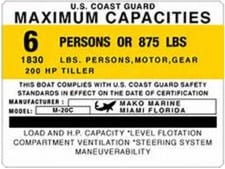 By Bob Currie, Vessel Examiner
By Bob Currie, Vessel Examiner
United States Coast Guard Auxiliary Flotilla 081-06-08
USCG Auxiliary Flotilla 081-06-08 is based at Coast Guard Station Galveston. The Auxiliary’s vessel examiners perform safety checks on all types of recreational boats. The list of equipment required by federal law is very minimal; however, the Coast Guard has several recommendations for consideration by the prudent and safe recreational boater. Many of the recommendations for recreational boaters are actually required of commercial vessels.
Capacity Plate
We have talked about this before, but the message bears repeating. An overloaded boat has been the cause of many bad incidents on the water. The capacity plate, usually affixed to the transom, gunwale or on the center console of a recreational boat, contains important information about the limits under which the vessel should operate to ensure safety.  It includes the maximum horsepower, the maximum number of persons and the maximum weight that may be carried (equipment and passengers combined). Capacity plates are required on mono-hull vessels under 20 feet in length. You may be tempted to take the number of persons on the capacity plate as the actual boat capacity, but if you take the time to do the math you will find that if you divide the “Persons” figure into the weight capacity, then the average person allowed for by the capacity plate weighs only 150 pounds. You should always consider both the number of persons capacity and the weight capacity and be governed by the most restrictive of the two. How many of you know the weight of your motor and the gear you bring aboard? The second weight capacity figure on the capacity plate is the total weight of persons, motor and gear. You should also keep that figure in mind when loading your boat with persons and gear. Picture in your mind, if you will, the scene from “Jaws” where all the boats are headed out to catch the great white shark, and most of the boats are grossly overloaded. The Richard Dreyfus character remarks, “They are all going to die.”
It includes the maximum horsepower, the maximum number of persons and the maximum weight that may be carried (equipment and passengers combined). Capacity plates are required on mono-hull vessels under 20 feet in length. You may be tempted to take the number of persons on the capacity plate as the actual boat capacity, but if you take the time to do the math you will find that if you divide the “Persons” figure into the weight capacity, then the average person allowed for by the capacity plate weighs only 150 pounds. You should always consider both the number of persons capacity and the weight capacity and be governed by the most restrictive of the two. How many of you know the weight of your motor and the gear you bring aboard? The second weight capacity figure on the capacity plate is the total weight of persons, motor and gear. You should also keep that figure in mind when loading your boat with persons and gear. Picture in your mind, if you will, the scene from “Jaws” where all the boats are headed out to catch the great white shark, and most of the boats are grossly overloaded. The Richard Dreyfus character remarks, “They are all going to die.”
One last safety recommendation in regards to capacity: once you have all your gear and persons aboard, check your freeboard. Freeboard is the distance from the water to the top of the gunnels at the lowest point. The counterpart to freeboard is the draft, the amount of boat below the water. Draft is not a fixed number; rather, it changes when your load changes. People always ask me what my draft is because my boat is designed for very shallow running. The answer is “it depends.” If I overload my boat, my draft increases and my freeboard decreases.

You might know what your average draft is on your boat, but you won’t know for sure what the maximum draft is until you actually measure it under full load. I have 21 inch sides on my boat. If my freeboard is less than half that amount with all persons and gear aboard, I won’t leave the dock until I reduce weight considerably. Keep in mind also that salinity changes buoyancy. You will float higher in salt water than you will in fresh water with the same load.
Accident Reporting
Boaters involved in a maritime accident are required to stop and render assistance to the extent that they can do so without endangering their own vessels, crewmembers, or passengers. When an accident occurs, it should be reported to authorities as required by federal, state, or local laws and regulations. If two boats are involved, the operators must provide one another with information about their vessels and the persons on board. Some states may vary in reporting times.
Federal law requires that reports be filed with the appropriate state agency for any boating accident that results in death; injury requiring medical treatment beyond first aid; damage totaling $2,000 or more to a vessel or other property; complete loss of a vessel; or the disappearance of a person under circumstances that indicates that death or injury is likely.
In cases involving deaths, disappearance, or injuries requiring medical treatment beyond first aid, local and state authorities must be notified within 48 hours. Reports on other accidents must be reported within 10 days. Some states may vary in reporting times. Each operator also must file a Recreational Boating Accident Report, Form CG-3865. Accident reporting requirements are also spelled out in the Coast Guard app.
Owner Responsibility
Under maritime law, the owner of a vessel may be held responsible for the safety and condition of his or her boat even if someone else is at the helm or if the owner is not on board and someone else is using the boat with his or her permission.
For more information on boating safety, please visit the Official Website of the U.S. Coast Guard’s Boating Safety Division at www.uscgboating.org. Questions about the U.S. Coast Guard Auxiliary or our free Vessel Safety Check program may be directed to me at [email protected]. I am available to perform free Vessel Safety Checks, and I will come to your location to perform them. SAFE BOATING!

 Posted in
Posted in 























